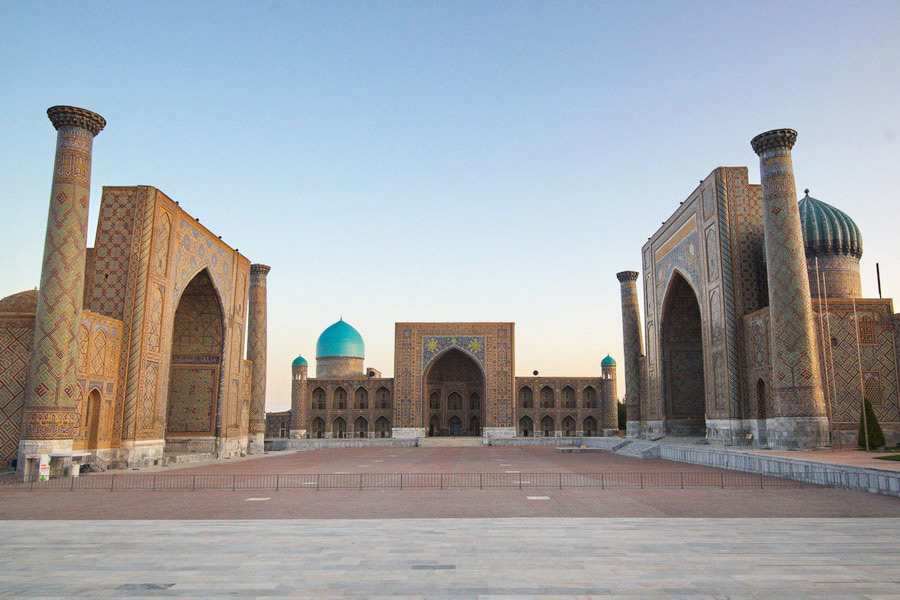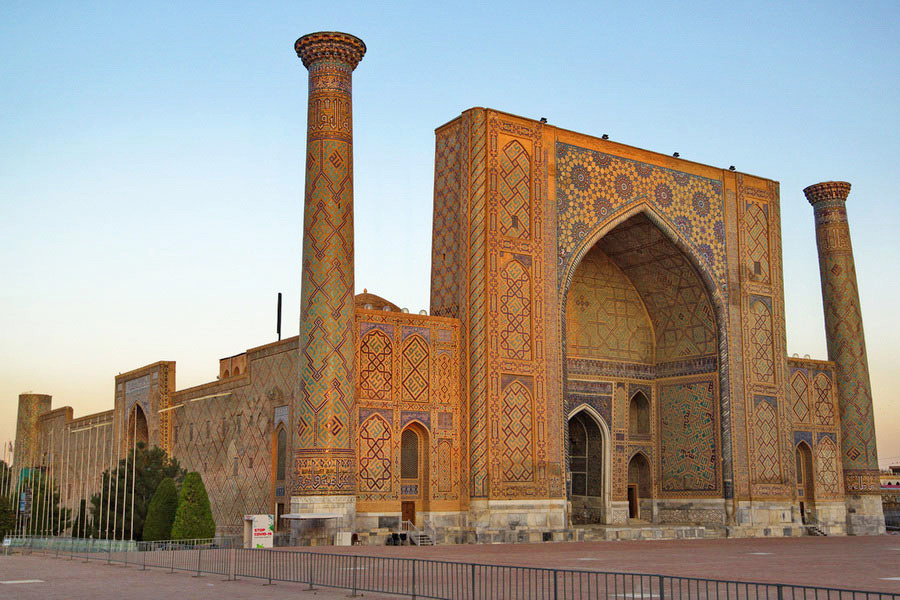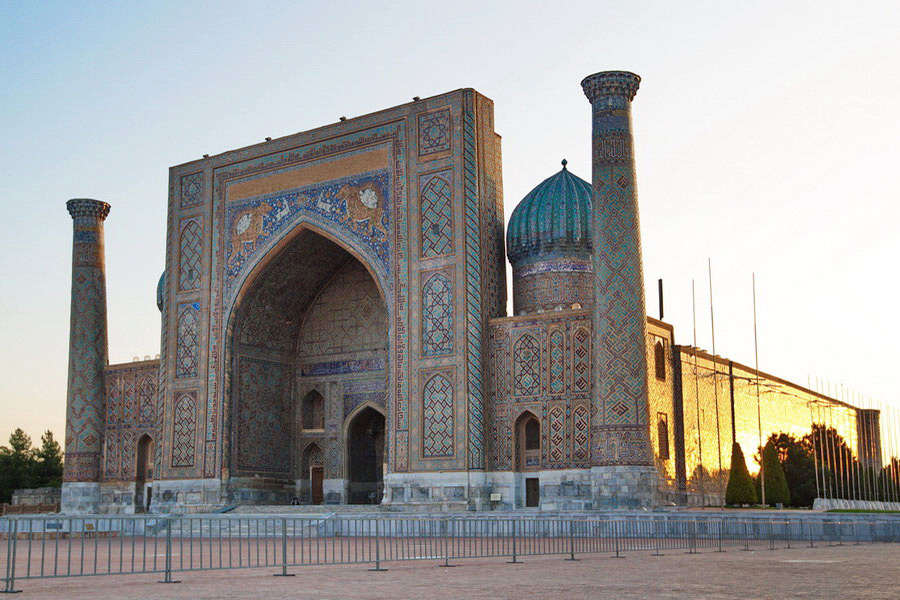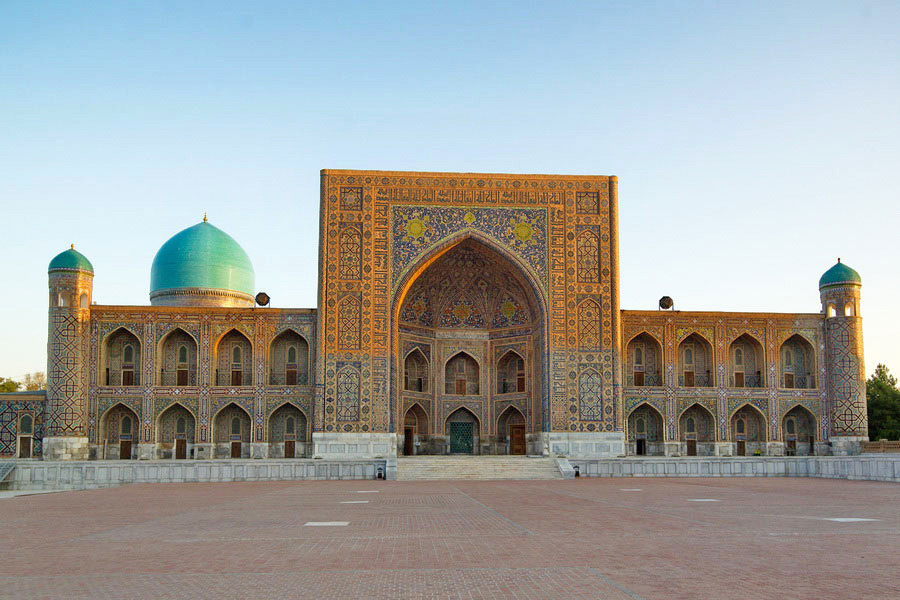
Registan Square is a real gem located in the heart of Samarkand and the undeniable centerpiece of nearly all Uzbekistan tours. Its grand architectural ensemble has earned it global fame and status as a monument of oriental architecture. From three sides, the square is surrounded with grand madrassah, portals of which are facing the center of the space. All three erections have their own unique décor. It is by virtue of these buildings, preserved on the territory of the city, Samarkand was included in the UNESCO World Heritage List in 2001.
The history of the Registan Square
Translated from Uzbek, “registan” means a sand place. In the ancient times, this central square was covered by sand. The territory was not initially surrounded by madrassah; those great erections appeared rather later. In that period, authorities of the city were gathering people on the square to announce khan’s orders, held celebrations and public executions, and collected the army leaving to war.
In the past, one could see many trade rows around the square, where artisans and farmers were selling their goods. All main roads of Samarkand led to Registan where it was always noisy and lively.
Various rulers during their reign would change the main significance of the square, but since those times and up to now, Registan has always been the center of the city social life.
There are three madrassahs on the square: Ulugh Beg, Sherdor (Sher-Dor) and Tilla-Kori, that are the main sights of the city. They were erected by two rulers at different times.
Ulugh Beg Madrassah

The heir of the great state of the Temurids, a well-known mathematician and astronomer Ulugh Beg, assumed the authority in 1409. In year 1417, he gave an order to build the madrassah that would later be renamed in his honor. It was the first erection on the Registan Square. The word “madrassah” stems from Arabic and literally means “teaching and learning place”.
In 1420, the construction of madrassah ended. On the outside, the building, located on the western part of the square, was done in the form of a rectangle; inside there is a square yard with entrances to the student cells (approximately for 100 people) and learning rooms. The façade of the madrassah looks out on the square, completed with two tall minarets in the corners. Special attention should be given to an exquisite interior of the building. Glazed bricks create beautiful ornaments on the yellowish laying of the walls. The madrassah portal is adorned with patterns of ten-pointed stars symbolizing the sky, and astronomy.
At that time, it was the largest scientific-educational establishment in Samarkand. Here students were taught philosophy, astronomy, mathematics, theology. Along with the madrassah, caravan-sarai and khanqah (hanaqa) of Ulugh Beg were constructed as well. Two centuries later, they would build two other madrassah on the place of the vendors’ shelter and khanqah, and they would complete the architectural ensemble that we can all see today.
Sher-Dor Madrassah

In 1612, Yalangtush Bahadur was appointed the emir of Samarkand. He was the governor-general of the Bukhara khans and by that time, he was already ruling feudal principalities, was known as a skillful politician and an educated commander.
Being a ruler of the city, he decided to construct another madrassah on the Square of Registan opposite the building erected by Ulughbek. According to the project of architects, the new madrassah was supposed to be located on the eastern side of the square and be a mirroring reflection of existing building on Registan. However, the exact mirroring concurrence did not work as the architect did not take one peculiarity into consideration – 200 years have passed since the construction of the Ulughbek madrassah, and the building had shrunk into the ground and the level of the square itself had risen to 2 meters. In the result, the new madrassah turned out to be taller. However, it is rather difficult to notice this different visually.
There was Ulughbek’s hanaqa located on the site of the territory planned for construction, that had noticeably dilapidated by that time. It was taken to pieces and the main part of the material was used for erection of the new building.
Construction lasted until 1636. Emir Yalangtush Bahadur wished his creation not to give in either in pomposity or space to the Ulughbek madrassah. Despite the fact that the façade of the building was completely resembling the first madrassah, they had used new technology in construction, not common in the 14th century. Workers applied rather progressive techniques that speeded the process.
Upon construction, the madrassah was named in honor of the ordering party. However, the name did not find its usage among people, and the building was renamed to Sher-Dor. The name comes from the images on the portal: two big golden tigers carrying a sun on their backs and heading after white fallow-deer were adoring the entrance. Sher means tiger (lion) and the name is translated as “adorned with tigers”. It was this plot that later became a national symbol of Uzbekistan.
Tilla-Kori Madrassah

Ten years later since the construction of the Sher-Dor madrassah, the ruler of Samarkand Yalangtush Bahadur had planned to erect another building that was supposed to complete the ensemble.
The construction began in 1646, in the northern part of the Registan Square, on the place of the caravan-sarai. The architect decided that the new madrassah should be another copy of already existing buildings, though would be located in the center.
The author of the project had an idea of achieving an architectural integrity of all erections and constructed the façade in the way that it visually created a closed space on the square.
The construction of the Tilla-Kori madrassah lasted more than 14 years and finished in 1660. The main façade of the building is done in two levels; the central portal is silted with a five-ended deep niche with two entrances leading to the inner closed yard. There is a blue-domed tower of the mosque to the left of the portal, with two minarets standing on both sides of the frontal part. The construction beautifully balances two bigger madrassah without disturbing the unity of the architectural style.
The name “Tilla Kori” was given thanks to its décor. Artists had used the painting method of “kundal” for decoration that contained mostly gilt. Among all three madrassah, this erection has a rich decoration of walls that leaves everyone impressed with the abundance of golden colors. Tilla Kori means “gilded”.
Registan Square. Now and then
It has been long since the moment of the first erection on the Registan Square up to now- already 6 centuries. In the end of the 17th century, Samarkand had gone through severe economic decline. The status of the capital city passed to Bukhara and merchants of the Great Silk Road would keep away from the city. There were only around 1000 families left in it at that time, and once wonderful buildings of madrassah were a shelter for wild animals. It was only in 1875 when Samarkand regained its past trading significance and the Registan Square was leveled and bridged.
However, in 1918 Samarkand faced changes again. The Soviet rule prohibited activity of any madrassah as religious schools. During this time, erections endured many natural damaging factors: earthquakes, harsh weather conditions. The larger part of the cladding of the building and the painting décor were lost. Nevertheless, it was the Soviet rule that had given the order to restore the entire Registan and give it the status of the significant historical monument on the Great Silk Road.
Restoration works had lasted many years and finished just before the fall of the Soviet Union. Scientists literally had to collect the whole interior and the exterior of the buildings and smaller façade fragments, restoring all elements.
The look that we can see on the Registan today is painstaking work of hundreds of restorers. If there was no decision taken during the Soviet rule to restore the unique monument, this beautiful ancient sight would never stand in front of our eyes.
Today different concerts, celebrations and other bright events of the city and the Republic are held on the Registan Square. Thousands of tourists’ daily flow to the square in order to see the grand beauty.
Registan is a valuable gift that we had inherited from our ancestors, embodying the entire charm of the eastern architecture.

